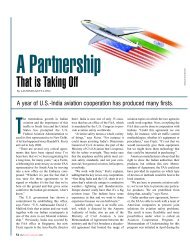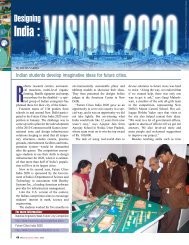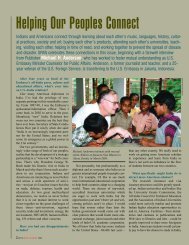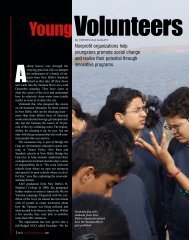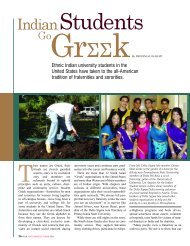The CHAI Project
The CHAI Project
The CHAI Project
Create successful ePaper yourself
Turn your PDF publications into a flip-book with our unique Google optimized e-Paper software.
36 SPAN MARCH/APRIL 2006<br />
Photographs courtesy <strong>CHAI</strong> <strong>Project</strong>
THE<br />
<strong>CHAI</strong><br />
<strong>The</strong> Pussimbing tea estate<br />
in Darjeeling is among the areas<br />
that have received assistance under<br />
the <strong>CHAI</strong> <strong>Project</strong>.<br />
PROJECT<br />
By DANIEL B. HABER<br />
Starbucks<br />
subsidiary helps<br />
Indian tea worker<br />
communities.<br />
SPAN MARCH/APRIL 2006 37
Tea is like the soul, the essence, and the clay cup is like<br />
the body,” explained Sanjay Gurung. <strong>The</strong> manager of<br />
the Darjeeling-based <strong>CHAI</strong> <strong>Project</strong>, Gurung recalls how<br />
his American audience—some 3,000 Starbucks store<br />
managers—were spellbound by his demonstration of the<br />
eco-friendly, one-time-use clay cup commonly used on Indian<br />
trains and his analogy between a cup of tea and a human.<br />
It may seem strange to have an Indian speaking about tea to<br />
Americans, a nation of coffee drinkers, and to its largest corporate<br />
retailer of coffee, Starbucks. But the Seattle, Washington,<br />
coffee company also has a tea company subsidiary called Tazo<br />
Tea, based in Portland, Oregon. In 2003, Tazo teamed up with a<br />
Portland-based aid group called Mercy Corps and the Darjeeling<br />
Ladenla Road-Prerna, a development organization, to form “<strong>The</strong><br />
<strong>CHAI</strong> <strong>Project</strong>.” It’s an acronym for Collaboration for Hope and<br />
Advancement in India. And, of course, as every Indian knows,<br />
chai means tea.<br />
Tazo, a buyer of Darjeeling tea since its inception in 1994, has<br />
worked with its partners, such as Starbucks and tea suppliers of<br />
the region, to provide close to $1 million for community development<br />
in the tea-growing regions of Darjeeling, improving the<br />
lives of some 12,000 people in 24 communities. This year it is set<br />
to expand to Assam, where it will help to diversify economic opportunities<br />
for tea-growing residents within Tazo’s supply chain<br />
of partner plantations. Mercy Corps, which is administering the<br />
project, is better known in Asia for its relief work in areas hit by<br />
natural disasters, but is now geared<br />
more toward development aid.<br />
While the world enjoys sipping<br />
the finest tea, produced in<br />
Darjeeling and Assam, few people<br />
realize that many of the plantation<br />
workers—those who pluck the fabled<br />
“two leaves and a bud”—live<br />
impoverished lives on the margins<br />
of society.<br />
When tea cultivation was first introduced<br />
in the Darjeeling Hills by<br />
the British in the 1800s, the area<br />
was sparsely populated and migrant<br />
laborers from neighboring Nepal<br />
were offered jobs. To this day, ethnic<br />
Nepalese form the major population<br />
of the Darjeeling Hills.<br />
Although the <strong>CHAI</strong> <strong>Project</strong> was<br />
originally conceived for the Darjeeling tea plantation communities,<br />
field assessments indicated that there were some adjacent<br />
villages that needed help as well. Of the 24 communities in the<br />
area involved in the <strong>CHAI</strong> <strong>Project</strong>, 10 are tea estates, eight are<br />
agricultural communities and six are forest communities. <strong>The</strong><br />
participants engage in what is termed Open Initiatives, meaning<br />
that they decide for themselves what kind of development is most<br />
important for them. “It could be a road, water system or biogas,”<br />
explains Gurung.<br />
38 SPAN MARCH/APRIL 2006<br />
A grocery store at Dairy Gaon, in Darjeeling district, is run by a<br />
self-help group with assistance from the <strong>CHAI</strong> <strong>Project</strong>.<br />
On a crisp sunny day in November, Gurung takes me to visit<br />
one of the remoter communities known as “Parment,” short for<br />
“permanent settlement,” where <strong>CHAI</strong> has a successful project.<br />
After breakfast at a café facing the famous Batasia Loop of the<br />
Darjeeling Himalayan Railway, a World Heritage site, we undertake<br />
a jeep journey of two hours over twisting hairpin turns. We<br />
travel from Ghoom, which is the world’s second highest train station,<br />
at 2,550 meters. We pass hills of emerald, jigsaw patterned<br />
tea bushes on the Takdah Tea Estates down through what look<br />
like pre-historic gorges and valleys where one might have once<br />
expected to find dinosaurs roaming.<br />
Surprisingly, nestled in the woods, we discover hidden citrus<br />
groves and we pass women with dokos (baskets) on their back<br />
carrying the juicy oranges destined for markets on the plains—<br />
another source of income for the Darjeeling tea communities.<br />
“This is what Darjeeling looked like before the Britishers converted<br />
it to monoculture tea plantations,” explains Gurung, who<br />
previously worked with the Veterinary Department.<br />
As we near the Parment village, we meet the 65-year-old headman,<br />
Padam Bahadur Mangar, known as “Mondal Daju,” and his<br />
23-year-old assistant, Santa Kumar Thapa, who are adjusting a<br />
water pipe that serves the community below. Walking down to<br />
the village of about 20 families, Thapa points out trees and<br />
shrubs—teak, sal and broom, which as its name implies is the<br />
raw material of brooms, a source of income for the community.<br />
We also pause at several honey-producing beehives.<br />
One of six in his family, Thapa<br />
has no intention of leaving his<br />
village. Until a few months ago,<br />
his family’s income depended<br />
entirely on the pension of his<br />
late father, a retired soldier in<br />
the Indian Army, and sustenance<br />
farming. Thapa joined the <strong>CHAI</strong><br />
<strong>Project</strong> in its early days and<br />
now serves as secretary of its<br />
Youth Club.<br />
Later, Gurung meets with the<br />
villagers in the one-room school<br />
house and discusses the feasibility<br />
of setting up a biogas unit.<br />
Several villagers feel that they<br />
wouldn’t have enough cow dung<br />
to make it feasible, and a lively<br />
discussion ensues. I use one of<br />
the newly constructed latrines and experience firsthand how the<br />
<strong>CHAI</strong> <strong>Project</strong> has benefited the community.<br />
Before leaving Parment, we meet with Rekha Thapa who, in<br />
her early twenties, is its newest and perhaps youngest entrepreneur.<br />
With a small loan of Rs. 5,000 provided by the <strong>CHAI</strong> Youth<br />
Program, she recently established a shop where she sells items<br />
such as salt, soap, spices, rice, cooking oil and eggs. She runs her<br />
business with the help of her husband, Prakash, and earns about<br />
Rs. 200 a day, which is not bad for a small enterprise in her rural
Nepal’s Coffee<br />
Makes Its Way<br />
into American Mugs<br />
I f<br />
Darjeeling is world famous for tea, neighboring<br />
Nepal is reaping the benefits of<br />
another plantation crop, coffee. Commercial<br />
coffee production in Nepal began in 1976 with<br />
the import of Arabica coffee from South India.<br />
At present, coffee cultivation is scattered over<br />
17 districts of Nepal’s hill regions.<br />
Even though coffee production is still<br />
minuscule in proportion to the demand, with<br />
only 65 tons exported in 2005, private companies<br />
such as Highland Coffee Promotion<br />
Company Ltd., Everest, Plantec and Gulmi<br />
Cooperative are exporting processed green coffee<br />
beans to the United States, Japan and some<br />
European countries. Last year Highland Coffee<br />
shipped 23 tons of coffee to Holland Coffee in<br />
the United States, a major supplier of<br />
community. She feels confident that she will be able to return the<br />
loan within the one-year time frame. Before Rekha set up her<br />
shop, the villagers had to walk 90 minutes to Simbong just to buy<br />
a box of matches. As Rekha puts it, “I am now optimistic about<br />
the future and have plans of expanding the business with the<br />
profits. Through the Youth Revolving Loan Fund, people like me<br />
can be self-reliant and benefit not only themselves, but also their<br />
families and communities.”<br />
Since large families exceed the tea plantations’ employment capacity,<br />
young people are left with few options to secure a job and<br />
diversify their skills. Yet they are the future of the community.<br />
“We discovered that unemployment among the youth in villages<br />
is very high,” says Gurung. “Our aim is to impart leadership<br />
skills and to train them in a vocation which would be useful<br />
and remunerative within the community itself, so that they don’t<br />
have to leave their own villages to find a useful role in life.”<br />
Given a grant of only Rs. 5,000, youth groups have planned<br />
debates, sports and traditional events that united 2,000 of their<br />
neighbors, some from across the border in Nepal. This soon<br />
evolved into inter-village networking activities, where young<br />
participants reported an increase in their self-esteem, advocacy<br />
skills and ideas for transforming their environment.<br />
Today, <strong>CHAI</strong> is also supporting more than 300 young people<br />
Starbucks, the U.S. retail chain.<br />
In 2002 USAID allied with Winrock<br />
International, a nongovernmental development<br />
group based in the U.S. state of Arkansas; the<br />
Nepal Highland Coffee Promotion Company,<br />
the Nepal Coffee Producers’ Association, the<br />
Specialty Coffee Association of America and<br />
other Nepalese organizations.<br />
<strong>The</strong>ir aim was to generate employment and<br />
alleviate poverty through environmentally and<br />
socially sustainable development of the coffee<br />
industry. <strong>The</strong>ir strategy is to improve product<br />
quality at all levels: farmer production, rural<br />
processing and marketing.<br />
Beneficiaries include farmers like 64-yearold<br />
Timlisina, who grows coffee along with<br />
other crops. His annual income has already<br />
A coffee cultivator at Kavre, one of the<br />
coffee-growing districts in Nepal.<br />
increased by about $200. His is one of the<br />
12,000 Nepalese household farms producing<br />
coffee and tea which have benefited from the<br />
alliance. Luke A. Colavito, agriculture program<br />
coordinator in South Asia for Winrock<br />
International, says the plan is to facilitate new<br />
production by some 6,000 smallholders within<br />
two years and set the stage for more than<br />
100,000 households to become tea and coffee<br />
producers in about 10 years. “This will provide<br />
strong examples of commercial markets benefiting<br />
poor, small farmers, and helping a vulnerable<br />
state like Nepal in a period of crisis,”<br />
says Colavito. —D.B.H.<br />
in pursuing vocational apprenticeships based on market demands,<br />
and establishing small businesses in animal husbandry,<br />
bee-keeping, electronics and others.<br />
During the 10-day annual Darjeeling Carnival, I met Ajay<br />
Edwards, chief carnival organizer and owner of Glenary’s, a<br />
famous Darjeeling restaurant. “When the tea industry first came<br />
to Darjeeling it was both a blessing and a curse,” explains<br />
Edwards as we sip Apoorva Tips organic tea. “Although it provides<br />
employment, it has always been a hand-to-mouth existence.<br />
Our concern is that we want to make the tea garden<br />
communities economically viable. If the local people are earning<br />
a decent living they [the local youths] won’t be creating any<br />
problems in town. We are very grateful for the work that the<br />
<strong>CHAI</strong> <strong>Project</strong> is doing for the community.”<br />
Darjeeling tea is famous worldwide, and even in some<br />
Hollywood movies, characters sometimes used to say, “Can I<br />
pour you some Darjeeling?”—meaning the finest tea. Americans<br />
find that same Darjeeling tea in Tazo blends, and can have pride in<br />
the fact that the tea company, rather than exploiting the tea plantation<br />
laborers, is helping them to improve their lives. <br />
About the Author: Daniel B. Haber is a freelance writer based<br />
in Kathmandu.<br />
SPAN MARCH/APRIL 2006 39<br />
BIMALA RAI COLAVITO





